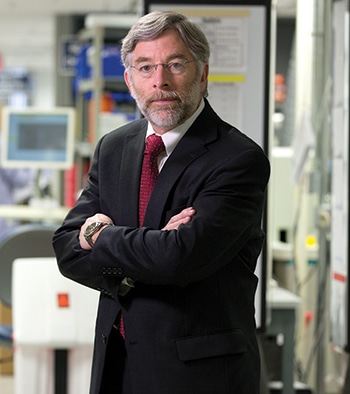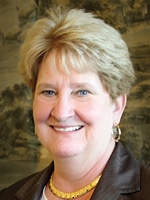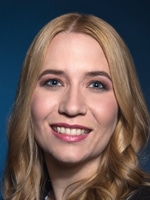Karen Titus
May 2020—Along with SARS-CoV-2, clinical laboratory testing has been hiding in plain sight far longer than many people realize. But it took the novel coronavirus (which, frankly, hardly feels novel anymore) to make that clear to the rest of the world.
As the COVID-19 pandemic spread across the globe, laboratory testing crashed the news cycle. National leaders sought to reassure citizens by promising millions of test kits. Economies shattered—and have since sought to return to life—based on testing availability. Ordinary people woke before dawn to wait in lines at drive-through testing sites—often to be turned away when supplies ran out. Emergency use authorization became a common phrase. And behind every heartbreaking photo from an emergency department or ICU lingered an unnerving thought: We don’t have tests.
“There are a lot of eyes on the lab right now,” says Tabetha Sundin, PhD, scientific director, molecular diagnostics and serology, Sentara Healthcare, a 12-hospital system based in Norfolk, Va. Like the 1968 Democratic Convention in Chicago, the whole world is watching.
Labs found themselves crisscrossing a no man’s land between “Anybody that wants a test can get a test” and “The tests are all perfect” to “It is a failing, let’s admit it.” How did their stories—the warnings, the scramble for tests and collection kits, the pleas from colleagues and politicians—unfold? And what lies ahead?

The international scope of the diagnostics business is hardly new to John Waugh. But the scarcity of the supply chain took him by surprise. “We’re as good as our next delivery,” he said of the testing in early April. (Photo: Dwight Cendrowski)
Distant thunder
John Waugh, system vice president, Pathology and Laboratory Medicine, Henry Ford Health System, spoke with CAP TODAY on April 3.
Or, as he puts it, “It’s about March 34th for me.”
Waugh and his colleagues at the Detroit-based system had been watching news reports about a novel coronavirus spreading elsewhere in the world, leading to lockdowns and health care crises. “But for a long time it was ‘over there,’” says Waugh. “It was China. It was Italy.”
Then cases started popping up in the Pacific Northwest. That’s when “a lot of people really dug in very, very hard on planning,” he says. Work had already been underway in various departments. But now it became a concerted effort to develop surge beds and double inpatient capacity.
The magnitude and speed of events was “absolutely unprecedented,” says Waugh. By April 2, Henry Ford hospitals were caring for 624 patients with COVID-19.
At Washington Kaiser Permanente, Dina Greene, PhD, also recalls that people weren’t all that alarmed initially. “At first we really weren’t sure this was going to be a big deal,” says Dr. Greene, technical director, Kaiser Washington Laboratories, who spoke with CAP TODAY on April 6. No one dismissed the threat, but many also carried memories of preparing for earlier viral threats that never materialized in the United States. “We had SARS fears, but nothing ever took off like this. With Ebola, we were worried about having containment areas and having safe places to test blood,” Dr. Greene says. But that didn’t extend to setting up internal testing capabilities.

We’ve always used lab testing to change behaviors, but this is on a global scale. It’s unprecedented.
— Dina Greene, PhD
“It’s like a hurricane, right?” she continues. “You know that the hurricane has demolished the Bahamas. You can see it coming, and it’s definitely raining, but that doesn’t necessarily mean it’s going to hit Florida.”
Dr. Sundin, who spoke with CAP TODAY April 7, recalls watching the numbers slowly tick up in the United States—about a dozen cases had been confirmed by mid-February—but not realizing until near the end of that month “that we were going to see a surge. Which may have been a little later than my colleagues,” she adds, noting she’d not experienced a pandemic before in her career.
Early on, she continues, “I thought, Oh, it’s not going to be a big deal, and our reference lab will support us, and the public health lab will support us.” As she and her colleagues realized “that those two sources would not be sufficient to handle the testing volume, we started reaching out to our vendors.”
Who has tests?
At the same time, vendors had started reaching back. “We were seeing vendors’ email, saying, We see this coming, or, We’re seeking an EUA,” recalls Dr. Sundin. “So at first, again, we thought what we had would be sufficient. In hindsight, we were not correct.” Her local site already had a small, low-throughput instrument in place, and they pursued in-sourcing a few additional instruments across the system. Contracting was assigned; reagents were expected. The lab could exhale.
“And then that vendor was not able to meet that supply—the instrumentation or the reagent,” Dr. Sundin says. “We also, at about that time, realized this is a huge deal.” At least 400 specimens a day were coursing through the system. A glimmer of hope appeared when their reference lab committed to a five-day turnaround time. That quickly ballooned to 10 days, though Dr. Sundin makes clear the lab was obviously doing its best to cope with unanticipated volume.
That’s when Dr. Sundin and her microbiology clinical specialist embarked on a divide-and-conquer strategy, as she puts it. Her colleague began working to source collection devices, including VTM, nasopharyngeal swabs, ESwabs—“everything at this point”—and Dr. Sundin began trying to source different reagents from different vendors, knowing that every vendor would be facing a supply chain disruption. They added assays to an instrument already in the lab; they also in-sourced a new instrument, setting up an entire COVID lab to accommodate its large size. By the first week in April, the lab had four live assays, with two more in the works. They also validated a second extraction for one of the methods—“so seven different validations, just to make sure we could supply the demand,” Dr. Sundin says.
Sentara wasn’t the only one embarking on an unorthodox scavenger hunt. As Henry Ford braced itself for the onslaught, “It became kind of a race here,” says Waugh. “The hospitals had to very quickly pivot and turn into acute care medical facilities. That’s hard to do. The whole hospital is starting to look like an ICU.”
Waugh points to a head-turning moment on March 17, at a Compass Group conference call on COVID-19, which he moderated. During the Q&A session, Waugh asked the VP of a major diagnostics company about reagent availability for labs with test systems already in place. The answer: Federal authorities were advising the company to redirect its instrumentation and consumable supplies to the largest commercial laboratories.
“That was shocking news to a lot of people on the phone,” Waugh says. “They had made investments in these test systems, and then they found out they weren’t going to be able to use them.” It also signaled to him that he’d need to start scouring elsewhere for supplies.
Early on, Henry Ford set up the testing system used by the CDC, which required consumable supplies from four different companies. This felt untenable to him. “If one of them doesn’t deliver, we’re dead in the water.”
Deliveries were indeed becoming doubtful. As so often happens, “Companies get very enthused about their offerings,” Waugh says. It’s a little like starting to sing in the shower before the water starts flowing. He received a stream of messages about what was available—“and then you find out they haven’t even started production yet, and they only made enough to get their approvals. And now they have an infinite number of requests coming from all over the world,” including hard-hit countries in Europe.
The international scope of the diagnostics business is hardly new to Waugh. Nevertheless, “It even took me by surprise how scarce the supply chain was.”

‘It has been tough to comprehend that raw materials to make kits and reagents aren’t available.’
—Beverly Rogers, MD
Even vendors sounded nonplussed. When Beverly Rogers, MD, chief of pathology, Children’s Healthcare of Atlanta, reached out to one longtime, high-ranking vendor colleague to ask about the possibility of getting tests, he said he didn’t know, given that the federal government was directing where kits were being sent. “I wish I could tell you more—everything changes hour to hour,” he told Dr. Rogers.
Waugh reports similar encounters. “Many suppliers—very senior executives within these companies—were worried,” he says. One supplier told him, “John, we have dealt with surges before, but we have never been backordered for flu testing supplies, even when we had something huge like H1N1. This is unprecedented.”
Waugh continues: “All of them, you could tell they were carrying big burdens. They weren’t looking at this as a sales bonanza. They were looking at this and saying, I don’t want to let anybody down.”
Waugh also had to beware of fraudulent offers for supplies that hadn’t been cleared by the FDA. Many came from China, he says, or from groups that were importing them. Some offers came through Henry Ford’s supply chain groups; others were forwarded by well-intentioned colleagues. “We had a lot of distractions,” he says. “We had to respond, politely, to nearly all those requests.”
LDT purgatory
The most obvious, pressing need was testing, Waugh says, to cohort and triage patients. “But we were prohibited from developing an LDT.” Instead, labs waited for the CDC to develop a test—later shown to be flawed—and to push it out to public health departments. Says Waugh: “Those tests that could be performed at public health departments would be recorded as presumptive positive until they were sent to the CDC, where they were retested. It was a glacial pace.”
He pauses, then adds, “It was a lost month.”
The public health system excels at tracking food poisoning outbreaks or outbreaks of certain focal points of disease, Waugh says. But it’s hardly a modernized system. Routing samples to state labs meant, among other things, filling out required forms. “When you’re in a worldwide pandemic, and a tsunami’s coming toward you, it’s not the time to reach for pen and paper.” The system also required calling the state health department and obtaining a tracking number for each sample.
“It’s a lot of waiting on hold, and that process quickly broke down,” Waugh says. Eventually the requirements for the forms and tracking numbers were waived. “It soon became apparent that the state public health laboratories were overwhelmed and backlogged.”

‘I’m so impressed by the collaboration between diagnostic companies.
I’ve never seen anything like it.’
—Tabetha Sundin, PhD
Labs also dealt with conflicting information from the CDC and the WHO, as well as shifting sample requirements. Early on, Waugh says, labs were told they needed to send an oropharyngeal sample and a nasopharyngeal sample to state labs; submissions that didn’t include both types would not be tested.
Directing testing to commercial labs was a good-faith attempt to catch up, but may have backfired as these entities were swamped, Waugh says. Some of his own send-outs to a commercial lab had 10-day TATs, plus transit time. “And then what comes back is a paper report,” he says, “instead of an electronically interfaced report to your information system,” since the lab didn’t do business with them on a regular basis.
Another eye-opener occurred Feb. 29. That’s when the FDA issued a new policy that allowed certain labs that had validated LDTs for COVID-19 to begin using them prior to FDA review; EUA requests then needed to be submitted within 15 days.
“That was momentous,” says Isabella Martin, MD, medical director of microbiology at Dartmouth-Hitchcock Medical Center, who spoke with CAP TODAY a week after the FDA’s announcement. “I think it’s the first time FDA has ever put something out on a Saturday.”
That whole week, every lab was focused on capacity, says Dr. Martin, who is also assistant professor of pathology, Geisel School of Medicine, Dartmouth College. “And how quickly can we develop these tests?” While the limits on developing LDTs are rooted in safety concerns, “That’s a huge problem when you’ve got this novel pathogen. High-complexity laboratories are used to thoughtfully validating LDTs, but once a public health emergency and EUA are invoked, all of a sudden you have to get through a lot of federal bureaucracy to start using a test.”
Waugh speaks more bluntly. “We actually had handcuffs on us at the federal level.”
Nevertheless, labs were prepared to move quickly, given the enormity of what they saw coming. “We were looking a pandemic straight in the eye,” Waugh says. “You have to make what-if plans.” If labs were eventually allowed to develop LDTs, how would they do so? What pieces would they put in play? How would they train staff, change IT systems, move consumable supplies? What could they reasonably promise to deliver?
Waugh reports that Henry Ford had its LDT ready by March 16. Its EUA was approved, and the system began testing. And again, there was worldwide competition for scarce testing supplies. “We’ve never had a situation like this before,” Waugh says. “Everybody’s competing for things like RNA probes.”
While he’s managed to acquire what the lab needs, Waugh notes the precariousness of the situation. “We’re as good as our next delivery.”
Dr. Greene, in Washington, reports a rapid rollout once the green light was given. When the state reported its first death on Feb. 29, she texted her colleague Alex Greninger, MD, PhD, assistant director, Virology Division, University of Washington Medical Center, and asked, When are we going to have a test? His answer came quickly: Text me tomorrow. “That’s how quickly he was planning on having his analysis completed,” says Dr. Greene. The test went live about a week later.
That eased some of her fears but created others. “It felt daunting to think that I was going to bring something online that hadn’t been properly vetted by the FDA and start giving these results to people immediately.” That’s not to say the new tests were necessarily bad, but there’s a reason laboratory directors and regulations exist, she says.
Initially she waited to bring testing in-house, preferring to send samples to UW “until we got our feet grounded and could make a less impulsive decision on which testing we wanted to bring in,” given that EUA options were starting to expand.
Who gets tested?
Like many other providers, Sentara set up drive-through collection sites. But when their reference lab was unable to tamp down TATs for those samples—10 days soon became 15—they shut it down. Dr. Sundin speaks with no trace of frustration in her voice. “Again, I firmly believe they were doing their best. We’re doing our best. So are all the diagnostic companies. We’re all trying to move very quickly to meet demand.”
The demand has been huge. “Everybody and their brother wanted to be tested,” says Waugh. But self-selection is not a good strategy, particularly when, as Waugh puts it, “a third of the United States decides they all want to be tested at the same time.”
Like other institutions, Henry Ford settled on a strategy that prioritized inpatients, followed by patients in the EDs—there are nine in the system. The third category covered health care workers, primarily those who exhibited symptoms of COVID-19 and took themselves offline for 14 days. After that, “We needed to be able to test them, clear them as negative, and then bring them back to work.”
The strategy worked well for a while, Waugh says. “Then we discovered other populations of patients,” such as people brought to the ED from a skilled nursing or long-term care facility because they had COVID-19 symptoms.
“Ultimately everyone got tested, but we did have to make choices,” he says. “Everybody could not be first in line.”
 CAP TODAY Pathology/Laboratory Medicine/Laboratory Management
CAP TODAY Pathology/Laboratory Medicine/Laboratory Management
